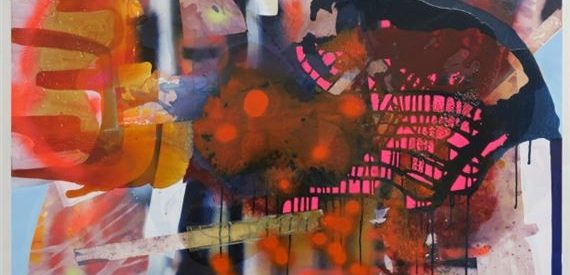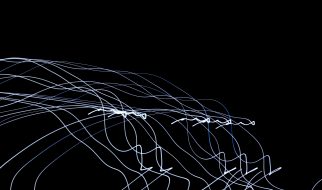Contemporary figurative painting has commanded much critical attention in recent years, but a spate of abstract shows signal a return to non-objectivity.
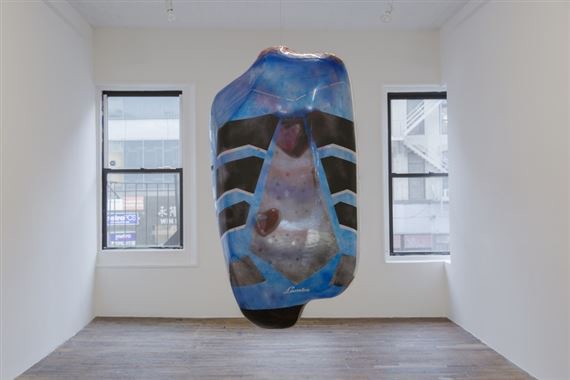 Ragen Moss, Senior Lender (with Mezzanine Lender, with Heart), 2019, acrylic, polyethylene, aluminum and steel hardware, 53x30x22 inches (courtesy the artist and Bridget Donahue)
Ragen Moss, Senior Lender (with Mezzanine Lender, with Heart), 2019, acrylic, polyethylene, aluminum and steel hardware, 53x30x22 inches (courtesy the artist and Bridget Donahue)
The term abstraction is nebulous and shifting; its meaning can differ according to context, experience and time. It can be problematic, too, as labelling a work as abstract immediately pits it against that which is representational. Some might argue that all art is abstract since whatever its subject, the work is always at a remove from the ?real world,? hence, an abstraction of reality. For the sake of this article, the term ?abstraction? is meant to describe a type of art whose central aim is not to re-present some aspect of the tangible world in pictorial terms. While the artists discussed here may indeed reference perceived phenomena, the people, places and/or things that they reference are altered/synthesized/reduced ? abstracted ? to the point where the what becomes secondary to the works? overall formal qualities like color, line, shape, texture, etc.
In recent years, there has been tremendous upswell of critical and market attention focused on contemporary figurative painting. This work makes use of the human form in a direct way, by depicting representations of people ranging from the hyperrealistic to the heavily stylized. The turn to figuration came on the heels of a decade of abstraction that culminated in what some have deemed ?zombie formalism:? a mode of abstraction that appears almost mechanical in its systematic or serial approach. But the type of abstraction discussed here is of another sort. This type of abstraction emphasizes the human hand and bears all the signs of the artists? engagement with their materials. In some ways, this type of abstract painting has its foundations in mid-century abstraction, and the artists discussed here each engage with the history of abstraction directly, if in varying degrees.
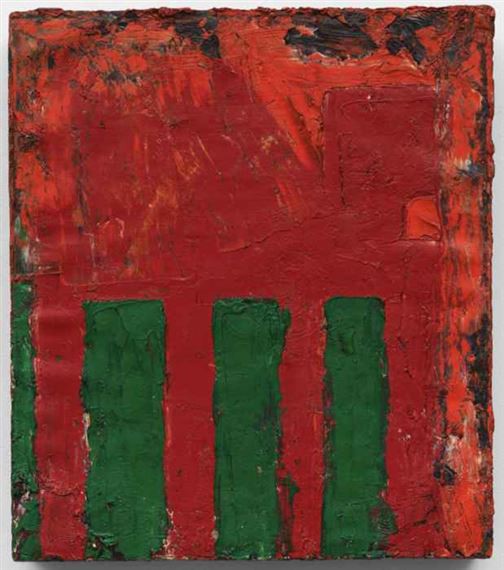 Chris Martin, Sphinx, oil on canvas, 16 x 14 inches (courtesy the artist and Anton Kern Gallery)
Chris Martin, Sphinx, oil on canvas, 16 x 14 inches (courtesy the artist and Anton Kern Gallery)
An exemplar of this kind of hard-won, resolutely individualistic abstraction is Chris Martin. For decades, Martin has been a kind of indie hero for painters. His omnivorous brand of inventive abstraction, his intense surfaces and the visionary quality of his paintings have made him a ubiquitous staple in the New York art world since the early 1980s. When Martin joined the stable of artists at Anton Kern, it signaled his ascent from underground painting hero to an established artist. The recent exhibition of Martin?s work at Kern highlights small-scale paintings from 1979?94: a formative period for the artist during which he developed his own personal lexicon of forms and his intensely worked yet fresh, refined surfaces. Take Sphinx (1986), for example, which suggests a four-legged form evocative of the titular creature. As in much of Martin?s work, the final image has a quality of inevitability and is reduced to its essence.
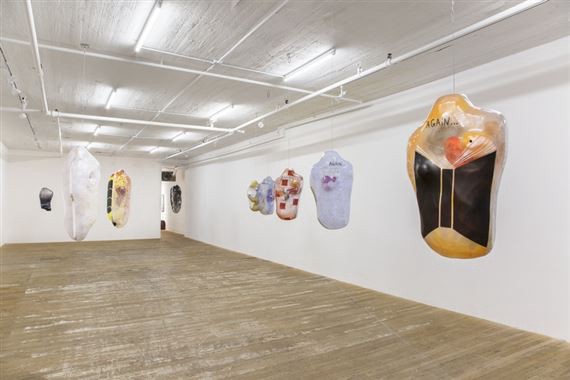 Ragen Moss: 8 Animals at Bridget Donahue, installation view (courtesy the artist and Bridget Donahue)
Ragen Moss: 8 Animals at Bridget Donahue, installation view (courtesy the artist and Bridget Donahue)
The term ?eccentric abstraction? was coined by art historian and critic Lucy Lippard in 1966 to describe work that ?evokes the gendered body through an emphasis on process and materials.? With their breast-like protrusions and cocoon shapes, the transparent, sculptural works of Ragen Moss on view at Bridget Donahue resonate with Lippard?s term, though they complicate what a ?gendered body? could mean. Upon entering the gallery?s second floor Bowery space, one is confronted by Moss? bulbous balloon-like works suspended from the ceiling. These objects, while appearing lightweight, command a sense of gravitas in the room. In some instances, text appears on the surfaces of the objects. In others, flat areas of color are printed on the latex surfaces as in Senior Lender (with Mezzanine Lender, with Heart) (2019). Moss? sculptures straddle the organic and the manufactured as the printed latex recalls commercially printed goods and the heart-shaped forms visible within the structure allude to a human chest cavity. Moss makes use of the most elemental features of sculpture: space, light, the body, and has reconfigured these elements in work that is fresh and new while harkening back to history.
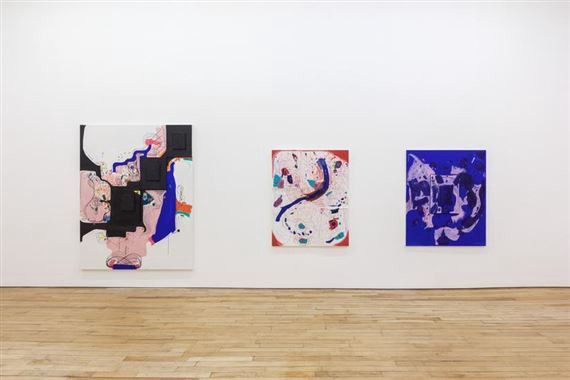 Joanne Greenbaum: I?m Doing My Face in Magic Marker at Rachel Uffner, installation view, 2019 (courtesy the artist and Rachel Uffner)
Joanne Greenbaum: I?m Doing My Face in Magic Marker at Rachel Uffner, installation view, 2019 (courtesy the artist and Rachel Uffner)
Just as Moss? works take an unconventional form, Joanne Greenbaum makes her foray into using glass as a medium in her recent solo at Rachel Uffner to expand the parameters of painting. In the first room of the gallery, a selection of kiln-formed glass paintings are displayed on narrow ledges lining the gallery walls. These slick, glittering tablet-like works are paired with a selection of Greenbaum?s large, ebullient abstract paintings in which bright swathes of swiftly applied paint meet child-like scribbles of red and pink. The exhibition?s title, ?I?m Doing My Face in Magic Marker,? alludes to a sense of play and mischief which are evident in the freewheeling mark making and joyous color combinations that animate Greenbaum?s work. Like Martin, a sense of levity and experimentation pervades Greenbaum?s practice. Perhaps it is this sense of freedom that can make abstraction so seductive. Where figuration has the potential to convey direct social, biographical and political commentary, abstract art tends to be more associative in nature. In other words, the works here open up a broad field of possibility for interpretation and give the viewer agency to draw parallels between the work and the world according to their own experience and cultural references. Likewise, abstract painting and sculpture inhabit the world in a different way. With their formal elements taking center stage (compared to say, narrative or the likeness of a figure) abstraction calls attention to itself as an independent thing rather than a depiction, which alters the ways in which one interacts and receives the work.
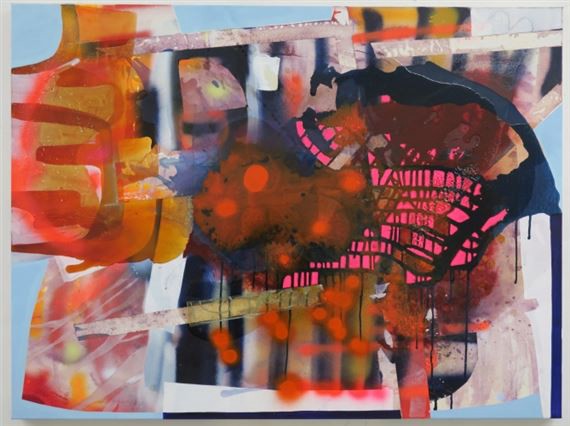 Erika Ranee, Mothership, 2019, acrylic, shellac, spray paint and paper collage on canvas, 30h x 40w in. (courtesy the artist and Freight+Volume)
Erika Ranee, Mothership, 2019, acrylic, shellac, spray paint and paper collage on canvas, 30h x 40w in. (courtesy the artist and Freight+Volume)
At Freight + Volume, painter Erika Ranee presents a new body of gestural abstractions in which a cacophony of painterly techniques collide into brilliantly energetic paintings. Central to Ranee?s process is the deployment of drips, stains and dense layers of pigment which are frequently combined with collage and more detailed passages. Despite the myriad colors and textures in Ranee?s work, she manages to deftly arrange and choreograph her mark making to create a sense of harmony. Like the aforementioned artists, Ranee?s paintings command one?s attention primarily through the feeling of energy that seems to radiate forth from the surface. While energy might seem an elusive metric for discussing art, it has something to do with the artists? physical engagement with their materials and the ways in which that relationship is transmitted back to the viewer. Because recognizable images are more or less removed from the equation, the human body is implied through the steps and procedures made manifest in the work itself. In this way, abstraction can lay bare primal aspects of the artist?s temperament and experience in ways not generally afforded the figurative artist who needs to contend with the specific needs inherent to representation.
For more articles, auctions, exhibitions, and current art trends, visit MutualArt.com
